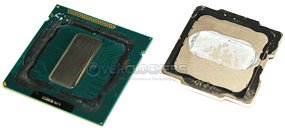- Joined
- Oct 9, 2007
- Messages
- 47,670 (7.43/day)
- Location
- Dublin, Ireland
| System Name | RBMK-1000 |
|---|---|
| Processor | AMD Ryzen 7 5700G |
| Motherboard | Gigabyte B550 AORUS Elite V2 |
| Cooling | DeepCool Gammax L240 V2 |
| Memory | 2x 16GB DDR4-3200 |
| Video Card(s) | Galax RTX 4070 Ti EX |
| Storage | Samsung 990 1TB |
| Display(s) | BenQ 1440p 60 Hz 27-inch |
| Case | Corsair Carbide 100R |
| Audio Device(s) | ASUS SupremeFX S1220A |
| Power Supply | Cooler Master MWE Gold 650W |
| Mouse | ASUS ROG Strix Impact |
| Keyboard | Gamdias Hermes E2 |
| Software | Windows 11 Pro |
PC enthusiasts with Ivy Bridge engineering samples, and reviewers at large have come to the consensus that Ivy Bridge is a slightly warmer chip than it should be. An investigation by Overclockers.com revealed a possible contributing factor to that. Upon carefully removing the integrated heatspreader (IHS) of an Ivy Bridge Core processor (that nickel-plated copper plate on top of the processor which makes contact with the cooler), the investigator found common thermal paste between the CPU die and the IHS, and along the sides of the die.
In comparison, Intel used flux-less solder to bind the IHS to the die on previous-generation Sandy Bridge Core processors in the LGA1155 package. Attempting to remove IHS off a chip with flux-less solder won't end well, as it could rip the die off the package. On the other hand, the idea behind use of flux-less solder in CPU packages is to improve heat transfer between the die and the IHS. Using thermal paste to do the job results in slightly inferior heat transfer, but removing IHS is safer. One can be sure that making it safe for IHS removal couldn't have been the issue behind switching back to conventional thermal paste, as everything under the IHS isn't user-serviceable anyway, and off limits for them. Perhaps Intel kept extreme overclockers in mind.

View at TechPowerUp Main Site
In comparison, Intel used flux-less solder to bind the IHS to the die on previous-generation Sandy Bridge Core processors in the LGA1155 package. Attempting to remove IHS off a chip with flux-less solder won't end well, as it could rip the die off the package. On the other hand, the idea behind use of flux-less solder in CPU packages is to improve heat transfer between the die and the IHS. Using thermal paste to do the job results in slightly inferior heat transfer, but removing IHS is safer. One can be sure that making it safe for IHS removal couldn't have been the issue behind switching back to conventional thermal paste, as everything under the IHS isn't user-serviceable anyway, and off limits for them. Perhaps Intel kept extreme overclockers in mind.

View at TechPowerUp Main Site
Last edited:










